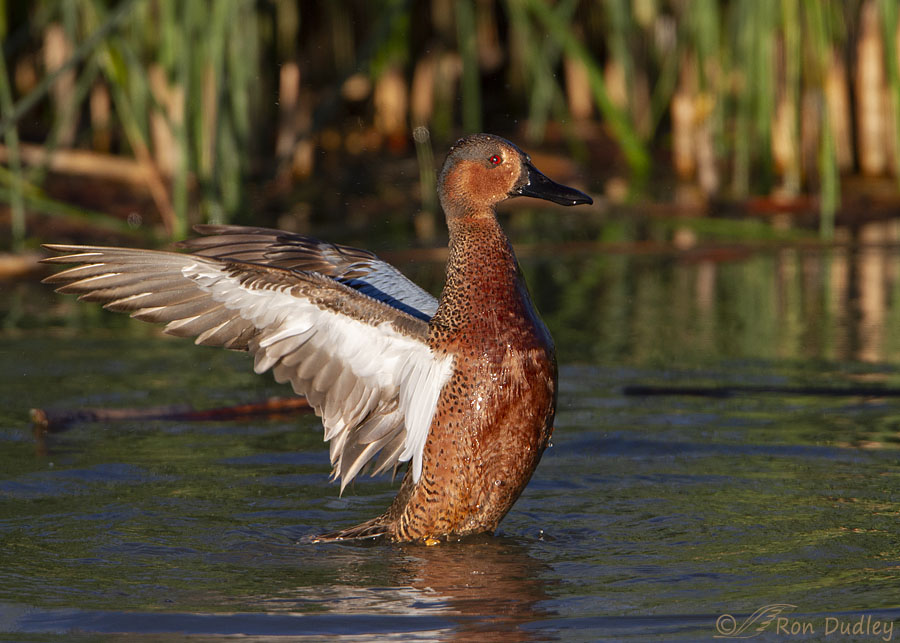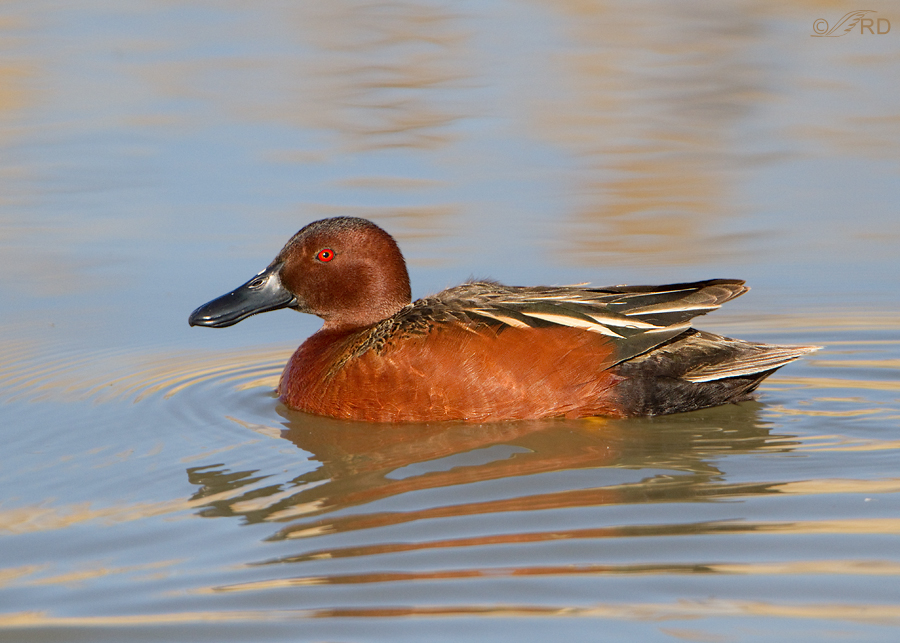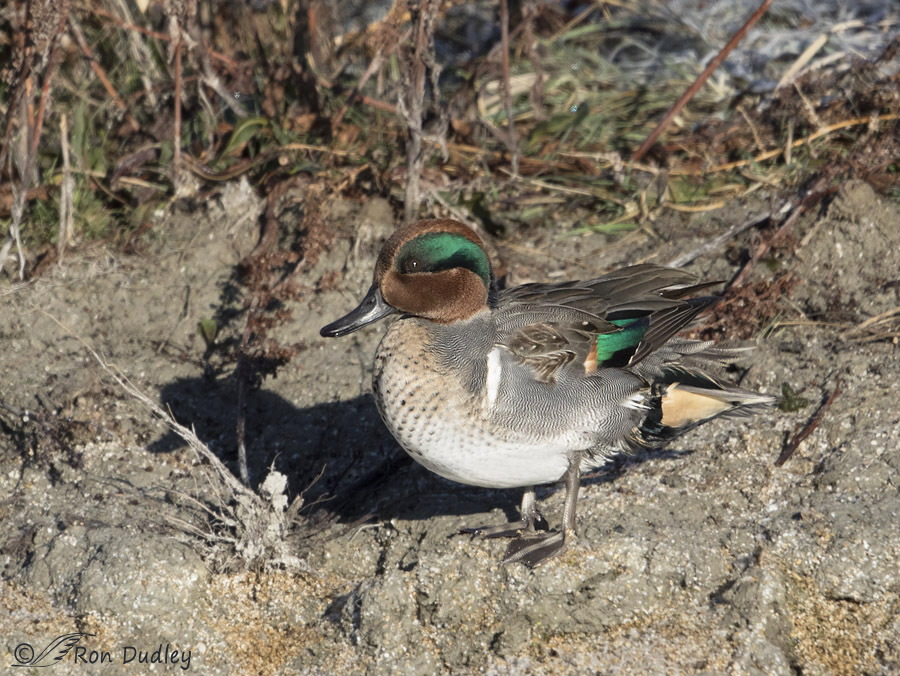Plus a question of ID.

1/800, f/7.1, ISO 500, Canon 7D, Canon EF 500mm f/4L IS II USM + EF 1.4 III Extender, not baited, set up or called in
I photographed this bathing male “Cinnamon Teal” nine years ago today at Bear River MBR. Often this species is quite shy but he was so intent on his bath that he ignored me during the entire extended process. I was able to get many interesting photos and I’ve posted several of them before but these three are new to my blog.

1/1600, f/6.3, ISO 500, Canon 7D, Canon EF 500mm f/4L IS II USM + EF 1.4 III Extender, not baited, set up or called in
Typical of many ducks when they’ve finished either bathing or mating he rose up out of the water and flapped his wings. His wings aren’t sharp due to insufficient shutter speed or depth of field or both.

1/1600, f/6.3, ISO 500, Canon 7D, Canon EF 500mm f/4L IS II USM + EF 1.4 III Extender, not baited, set up or called in
But two frames later I caught him with his wings in the opposite position and this time they’re sharp.
While I had this guy in my viewfinder I wasn’t even aware that he had at least one unusual characteristic indicating that he’s a hybrid – that remnant of a different colored crescent shape running through his eye to the back of his head. But I certainly did notice it when I arrived home and reviewed my images from the morning. I realized that this bird was apparently a Cinnamon Teal/Green-winged Teal hybrid.
Breeding male Green-winged Teals have a distinctive iridescent green crescent on their head that matches the shape if not the exact color of the crescent on “my” specimen so I was fairly certain about his mixed ancestry. And several of my friends who are very bird-knowledgeable agreed with my amateur assessment that the male I photographed was a Cinnamon Teal/Green-winged Teal hybrid.

This is what a “normal” male Cinnamon Teal in breeding plumage looks like. Notice that they lack that crescent shape on their heads.
However, since I took these photos nine years ago there has been some question from others about the ancestry of “my” bird. Some say that it’s actually a hybrid Cinnamon Teal/Blue-winged Teal instead of Cinnamon Teal/Green Winged Teal. The former combination has been documented in nature fairly often while an online search reveals no other examples of the latter.
Personally I don’t see it but what do I know about duck hybrid ID (the answer is a resounding “not much”). So I’m curious if any duck experts out there might want to weigh in and share your thoughts.
Ron



There appear to be a couple of more knowledgeable people commenting on the id of this fine duck, I do think it is interesting and congratulate you on this capture.
I agree with previous comments on this post. While I do think it is a cross between the blue winged teal and the cinnamon teal, it is a beautiful bird. I always love to see crosses and try to figure out what the mix is. We have seen quite a few over the years and all are interesting.
Travis, Well, Cinnamon x Blue-winged Teal seems to be the consensus so since I’m relatively ignorant on the subject I’ll bow to the majority and concede the point. With some reservations…
Yet another delightful stat to my day.
A gorgeous bird, and knowledgeable comments. Win/win. And I love the duck in his ‘preparing to walk on water, because I can’ pose.
It sounds like you’re having a better day than you were a couple of days ago. I’m glad if that’s the case. Thanks, EC.
Ron, interesting comments from you and readers about the hybrid aspect [of which I know nothing]. All I can say is that these photos are a work of art. The color of the birds and the different ‘poses’ are just amazing. Thank you for posting, Ron
I’m glad you like them that much, Alice. Thank you.
This is such a nice series…love the bathing beauty in the first image and the water patterns in the last especially…
Thank you, Patty.
Cinnamon and Blue-winged Teal are very closely related and frequently hybridize in nature. Cinnamon Teal also hybridizes with Northern Shoveler, although less frequently. Green-winged Teal is not known to hybridize with Cinnamon Teal and in fact, rarely hybridizes with other ducks, although hybrids with Northern Shoveler and American Wigeon have been reported. Evidence suggests that Cinnamon and Blue-winged Teal only recently (in evolutionary time) diverged from one another and are more closely related to each other than many other species of ducks are.
I see the coloration over the eye, but this may be caused by something other than hybridization. The bit of white in front of the eye suggests Blue-winged Teal, although is it s very small patch.
Very interesting info, Dan. I of course bow to your advanced knowledge but the fact that the “patch” over the eye is the same shape, same size and in the same place as the green iridescent patch on a Green-winged Teal just seems like too much of a coincidence to me. Personally I just can’t get past that.
Wish we could do a DNA test..
Gorgeous! Gorgeous! Gorgeous! I kinda hope he is “your” hybrid because I want to imagine that iridescent green against the cinnamon when he’s a-courtin’ the ladies.
Thank you, Marty. To be honest I didn’t notice any iridescence in that patch in any of my photos of him.
Will leave it to the experts on the specific hybridization, although thanks to your sharp eye for noticing it at all.
Personally, I suspect it’s a cross between a strikingly beautiful bird and great photography.
I love that, Lyle! So do I!
Lyle, The bird gets most of that credit, no question about it. Thank you.
I can see evidence of both. As you mentioned, the dark band behind the eye as in Green Winged, but also traces of the white crescent in front of the eye and speckling around the neck and breast of the Blue-winged. However, in looking at other photos of Blue-winged / Cinnamon hybrids (example: http://www.10000birds.com/hybrid-teals.htm), I also see the dark band in combination with more predominant white crescent and speckling. So if I had to guess, I’d say it’s probably Blue-winged / Cinnamon hybrid. Perhaps it’s a second generation hybrid. A cross between a Blue-winged/Cinnamon hybrid and a pure Cinnamon. In any case, thanks for sharing. It’s very interesting.
You made some interesting and valid points, David. A confusing bird, that’s for sure.
DNA would settle this but without it you always have an opportunity for disagreement. To my eye its morphology fits your conclusion, but who am I to say?
At least you see what I see but who really knows what the genetic reality is – certainly not me. Thanks, Ken.
Clueless on the ancestry BUT these are GORGEOUS photos of gorgeous birds…. The Cinnamon Hybrid is beautiful – glad he cooperated.
The Cinnamon Hybrid is beautiful – glad he cooperated. 
I think they’re pretty neat photos too, Judy. Perhaps some of the reeds in the background are a little bright but they don’t bother me much. Thank you.